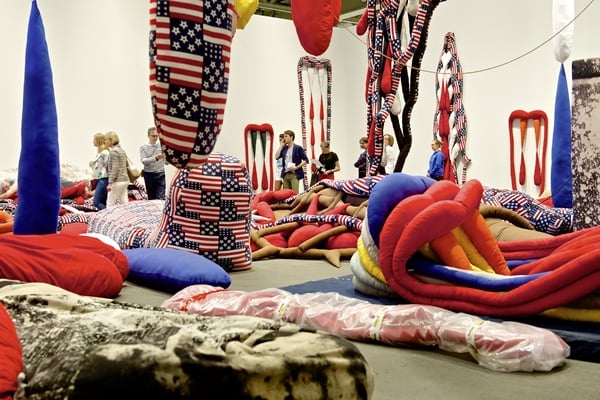
Courtesy Xavier Hufkens, Sprueth Magers, Berlin, London, MCH Messe Schweiz (Basel) AG.
Pascale Marthine Tayou, Art Basel in Basel 2014, Unlimited.
Courtesy: Galleria Continua.
How joyous it is when an art fair surprises. It doesn’t happen often, not in the fair itself, anyway, where booth after booth can look like so many white coffins in an art world mortuary. This is where art comes to die. But the Unlimited sector of Art Basel, dedicated annually for the past 14 years to showing large scale artworks and performance, is so strong this year as to be alone worth the arduous trip to Basel.
Unlimited looks and feels like a coherent exhibition. It actually reads like a biennale and yet is probably better than many of them, with 78 individual artist projects in all media spread across the 21,500 square meters of Hall 1 at the Messe. It is meant for work that is not for sale, supposedly, though the presence of dealers around works by artists from their gallery during the opening was an unwelcome reminder of the overall, larger commercial context. Be that as it may, the artworks here hang together cohesively.
Several ingredients went into making this show a success. The curator, Gianni Jetzer, had the benefit of having been invited back for a third year to organize the show—he knew the venue, its strengths and its limitations, and through judicious selection and presentation has assembled a pleasurable, stimulating new show. This year, too, Art Basel moved Statements, its sector for young and emerging galleries, out of Unlimited, located in Hall 1, and put it into Hall 2 alongside the rest of the galleries where, frankly, it really belongs. This gives a younger generation of artists a more prominent place in the main fair while freeing up space in Hall 1 for a more coherent curatorial presentation. The earlier migration of the art magazines and daily conversations and salon talks into this venue now makes a lot more sense.
Troika, Art Basel in Basel 2014, Unlimited.
Courtesy: Galeria OMR.
This year’s Unlimited is also the first to be staged in the newly redesigned Hall 1 space by Herzog & de Meuron. The space is more generously proportioned and laid out with an open plan with artworks in little self-contained purpose-built rooms. They are on the walls, lying on the floor, or hanging from the ceiling around a central, elongated diagonal line made up of 300 steel plates, Steel Peneplain, Carl Andre’s contribution to Documenta 7 in 1982. It is a clever curatorial conceit to use Andre’s signature sculpture to unite the artworks and help the visitor to navigate what is otherwise a colossal empty space. This is brilliant curating.
The show itself is nuanced and thoughtful, in a way that an art fair can never be. It’s multi-generational, and racially, socially and geographically diverse with an accent on powerful statement pieces. Kara Walker, Haegue Yang and Zhang Huan open the show, with monumental if familiar paintings and sculpture—familiar, I should say, to those who frequent global exhibitions, biennales, and fairs. Yang’s installations of colored aluminum venetian blinds, for example, hung in the entry to Art Basel in Hong Kong, while Zhang’s impressive ash paintings and more recent works are fixtures at art fairs these days.
Harold Ancart, Art Basel in Basel 2014, Unlimited.
Courtesy Xavier Hufkens MCH Messe Schweiz (Basel) AG.
Zhang, a celebrated Chinese artist, currently has an outdoor exhibition at Storm King in upstate New York, and there is a tendency here to include artists currently in demand or in the media: the Los Angeles scene is well represented, courtesy of young hipster artists and collector favorites like Sam Falls, Sterling Ruby, and Alex Prager. The Turner prize winner, Laure Prouvost, is showing in here alongside legendary figures of American, European and, yes, even Asian art, including Bruce Nauman, Michelangelo Pistoletto, Rosemarie Trockel, Richard Long, Giuseppe Penone, Lee Ufan, Anthony Caro, and Yasumasa Morimura.
Minimal-conceptual artworks are the standard, as has been for decades now in the art world, though it is laudable to see the curator reach deeper than the usual suspects. British artist Alice Channer offers us reams of fabric with digital camouflage designs to reflect on the fashion industry, while the American William Leavitt’s disjointed but oddly intriguing sculptural installations about time and decay deserve, it seems to me, to be much better known—these reveal gaps in American gallery and museum programming. This senior Los Angeles—based artist shows occasionally in New York with Greene Naftali.
Bruce Nauman, re-enactments of Bruce Nauman’s 1968 video Wall Floor Positions.
Presented at 14 Rooms in Basel by Fondation Beyeler, Art Basel, Theater Basel in 2014 MCH Messe Schweiz (Basel) AG.
There is lots of video, mostly inaccessible during the crush of an opening, sadly, along with some fun and happily accessible interactive, environmental installations. Cameroon’s Pascale Marthine Tayou presents a chaotic store environment that resembles an African marketplace, while German John Bock continues his exploration of what he terms “art welfare” with biting social and political critiques blending sculpture, video, and installation art in the vein of Bruce Nauman. His work isn’t pretty but it is affecting and real.
Bock is one of those artists that the art world is infatuated with, in spite of the fact that he and his work rebuff the viewer, even the art market. I guess that makes him even more attractive to some collectors, curators, and dealers, but nonetheless a mildly surprising inclusion here. I like that, for it challenges me, even provokes the sensitive visitor at a time and place where everyone and everything is about making money. Suspend disbelief for an hour or so and see this show, please. Then you can all go shopping.
Sterling Ruby, Art Basel in Basel 2014, Unlimited.
Courtesy Xavier Hufkens, Sprueth Magers, Berlin, London, MCH Messe Schweiz (Basel) AG.